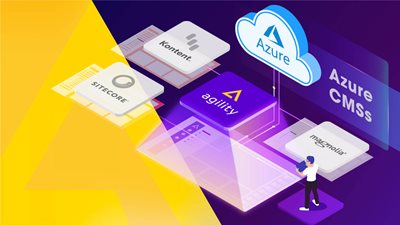9 Benefits of Headless Commerce for Enterprises
Why enterprises are going headless


As enterprises rush to provide more custom and engaging user experiences, they are reevaluating their current commerce platforms and solutions. Enterprises that use traditional commerce are restricted by pre-built solutions that result in generic experiences for customers. Many companies are transitioning to headless commerce to provide a robust infrastructure to serve their customers. Some of the major benefits of switching to headless commerce from traditional commerce include:
Personalization

A key added value of switching to headless commerce is added personalization for both the enterprise and the customer. The modern consumer is used to personalized shopping experiences due to giants like Amazon using endless software to provide recommendations based on a customer’s behavior. With headless commerce, you can provide a similar personalized experience for your customers. Since the backend and frontend are decoupled, you can make changes to your frontend without impacting your infrastructure. This allows you to continuously experiment with frontend experiences to make your user experience as personalized as possible.
With headless commerce, you can use the backend data on your customers’ previous purchases and activity on your site to inform your frontend experience. You can customize merchandising, use chatbots to help with customer service, streamline payments and get further insights on browsing behavior with headless commerce. These advancements made in your user experience and backend with personalization will allow you to make tangible improvements in your clicks, conversions, and sales.
Flexibility
One of the key pain points for enterprises that use traditional commerce is the static storefronts and operations of their website. Although pre-built templates can be good to get a minimum viable site and hit the market, it’s not sustainable for a growing enterprise. Headless commerce solves this pain point by giving the ultimate flexibility to enterprises. With headless commerce, all that is needed is to get data through an API call. There are no backend limitations and you can craft your user experience from the ground up and personalize it.
The agility provided by headless commerce also enables you to test frequently and continue to optimize the experience for your users. Since the frontend does not impact the backend, you can set up A/B testing and other controlled experiments to see exactly what your customers respond to best and incorporate that throughout the whole site. Additionally, your site can adopt new trends fairly easily. Your developers can set up specific APIs that will enable new functionalities on your site and allow you to capitalize on any emerging trends related to your customers.
Integrations
A great benefit of headless commerce solutions is the limitless amount of integrations possible. With traditional commerce, your business is limited by plugins that require continuous updates and patches. Additionally, the plugins are not custom-made for your operations and cannot provide tailored services. Headless commerce enables enterprises to use APIs that can easily integrate with existing systems.
These integrations can enable you to improve your marketing automation, get more detailed analytics on your operations, and more. Examples of integrations you can use with a headless commerce solution include tools like a CMS, CRM, etc. Since the integration for headless commerce is done by APIs, the possibilities for integration are virtually endless.
Employee adoption
When choosing a commerce solution for your business, a key element you should consider is the ease of use for employees. Adding a new technology or solution into your online business will often need at least a little bit of training for employees, but some solutions are far more complex than others. Fortunately, using a headless commerce solution is one of the easiest technologies to adopt in your business. Since the frontend is decoupled from the backend, any employee can make any necessary changes to the frontend without needing technical skills.
This can be a great opportunity for creative employees that don’t have the technical expertise to make improvements to your front end. This can include staff like designers, writers, UX personnel, and more. By removing the technical barrier to the front end of your website, you can have extensive improvements made on the front-end interface of your website. Your technical staff and non-technical staff can collaborate and create the most engaging experience for your customers. This is also a great way to improve employee engagement and satisfaction.
Case Study: Agility CMS Headless commerce solution increases ticketing revenue by 20%
Time to market
The time to market for your enterprise can be reduced dramatically when you adopt headless commerce. If you have an enterprise of any scale, you know how time to market can be slowed down by adopting new channels, selling omnichannel, selling internationally, etc. This can slow down your operations significantly and it can be detrimental if you’re in a competitive market. Since headless commerce has independent backend and frontend operations, your developers can work on technology, while your marketing team deploys campaigns and other initiatives. This allows your marketing team to reach the market within days instead of weeks or months.
With headless commerce, the content publishing and products of your site can be delivered by APIs virtually anywhere. This directly reduces the time to market for enterprises and allows products and services to be launched and iterated on faster. By reducing the time to market, you can get customer feedback quickly and gain a competitive advantage over competitors.
User experience
User experience is one of the main reasons headless commerce emerged. For decades, companies were limited to the static and stationary experiences provided by traditional commerce. Unless you were a multi-billion dollar corporation, having a headless commerce system simply wasn’t feasible. With the accessibility of headless commerce today, you can create virtually any user experience for your website. With the versatility of the backend of headless commerce, there are limitless user experiences options for your website.
Headless commerce allows you to design channel-specific user experiences, omnichannel customer experiences, and more. You can segment your audience and create personalized experiences based on their demographics, interests, and behaviors. This will allow you to create engaging experiences which ultimately lead to more conversions and sales for your business.
Conversion optimization
A key benefit of headless commerce for enterprises is the advanced conversion optimization capabilities. This is one of the most tangible benefits of headless commerce because more conversions directly lead to more revenue. With traditional commerce, you are limited by what types of conversion optimization tools you can use. Since you can customize your backend with headless commerce, you can gain an array of new conversion tools to improve your marketing campaigns.
With headless commerce, you can optimize your product placement, use a variety of call to action buttons and provide a tailored customer experience for your users. Brands that have switched from traditional to headless commerce have seen a median conversion rate increase between 15-30%. Depending on the size of a business, these can mean thousands if not tens of thousands of dollars in additional revenue just by switching to headless commerce.
Cost savings
A common misconception amongst businesses is that headless commerce costs more than traditional commerce. With all of the benefits provided by headless commerce solutions, it’s mistakenly assumed that it costs a lot more than traditional solutions. Switching to headless commerce can actually result in significant savings for an enterprise. Since headless commerce does not require licensing and hosting fees, enterprises can save thousands of dollars by transitioning to headless commerce.
Traditional commerce solutions often have significant licensing costs and hosting costs for frontend operations. The high costs of traditional commerce still come with pre-built permissions and a lack of customization. Since headless commerce requires less infrastructure spending and fewer costs post-launch, it’s more affordable than traditional commerce. Additionally, the higher ROI generated by headless commerce makes it much more cost-effective than traditional solutions.
Improved security
Since a headless commerce solution's frontend and backend systems are decoupled, this prevents a breach from the frontend reaching backend systems like customer records and payment systems. Additionally, headless commerce provides additional security options for enterprises to use like least privilege principles, API authentications, and more. The decoupled infrastructure of headless commerce makes it more resilient to cyber attacks, but you can also add additional features to ensure your enterprise has extra layers of security.
It’s also important to note that your backend systems are following all of the data compliance programs relevant to your business. This will prevent you from violating any data security regulations where your business operates. Examples of these compliance programs include GDPR, PCI, CCPA, and more.





